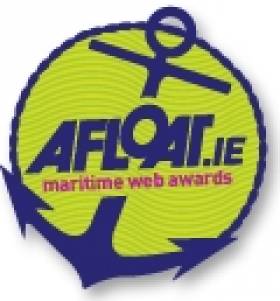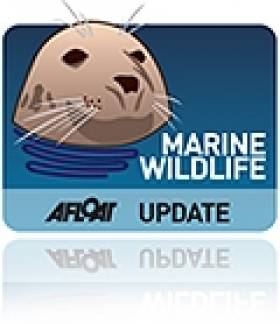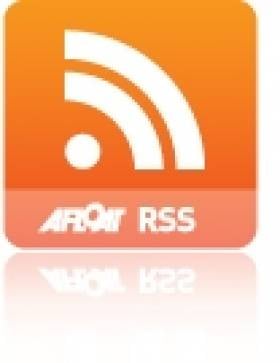Displaying items by tag: website
New Website For Schools Promotes 'Water Safety Fun'
#WaterSafety - Irish Water Safety (IWS) has launched its new water safety website for primary school teachers, pupils and parents.
The site for IWS' Primary Aquatic Water Safety programme, or PAWS, combines clear, simple water safety messages with material for use in classrooms, as well as free certificates for children who complete the programme.
Though designed for delivery in primary schools, IWS says the resource can help generally to change the attitudes and behaviours of children playing in, on and near the water – whether by the sea, on the beach, by the river, canal or any body of water.
Noting that 30 children aged 14 and under drowned in the last decade, IWS hopes that teachers will set aside some class time for the new website before the summer holidays to help everyone respect the water and make 'Water Safety Fun'.
Irish Maritime Web Awards Presented By Afloat.ie
#maritime – Getting your message across has never been easier thanks to the power of the internet. From computers to smartphones to tablets, access to the web today is almost ubiquitous - increasingly even out on the water! - and it's often the first place marine-minded people go to find whatever they're looking for, whether it's buying a boat, looking up sailing conditions or checking out a new club to join.
So it nearly goes without saying that websites are the first line of interaction with the public - the virtual shopfronts that put across who you are, what you do and how you can be of service, often at little more than a glance.
In light of this, it's no surprise that a great web presence - a well-designed usable website, topping the web search tables with active social media connections - can mean the difference between boom and bust for any business or service, especially in the current economic climate.
But since everyone else is getting on the web, too, it's becoming a lot harder to get noticed in the crowd. No longer is it enough just to look good. Winning websites must form part of a digital strategy: attracting interest, getting talked about and making an impact beyond the bytes.
What do web users want? How can we reach them? And how do we keep them coming back? That's the biggest challenge for clubs, organisations and businesses in the marine and maritime sectors in this digital age.
We at Afloat.ie know this more than anyone, which is why we've decided to recognise the best in what we and our readers see in Irish marine digital communications with the inaugural Maritime Web Awards.
We want to highlight excellence in marine websites making the biggest mark across a variety of categories, from the business end (brokerage, chandlery, ports and marinas) to those vital services (water safety, rivers and canals, watersports) for anyone who takes to the water, whether on the coasts, offshore or inland.
Nominations for the first Afloat.ie Maritime Web Awards were accepted on any and all marine-based websites via comments on Afloat.ie and on Twitter and Facebook. Selected sites were then scored for design, usability, interaction, social media, community and speed, with voting taking place with a judging panel representing our 11 award categories: Sailing, Brokerage, Chandlery, Clubs, Classes, Safety, Inland, Ports, Marinas, Watersport and Conservation.
The sites awarded below represent our judges' choices of the best of the web in Ireland's marine and maritime sectors in a landscape that's constantly shifting. But that's exactly why these sites deserve our recognition - they're keeping ahead of the curve, and will surely adapt to what changes may come in the next few months, let alone years.
So without further ado, the winners of the inaugural Afloat.ie Maritime Web Awards are...
Sailing Award
SailCork - www.sailcork.com

Coming in tops for its search engine ranking and easy-to-navigate website that's constantly updated with the latest course offerings and blog updates, SailCork looks forward to its 40th year in business with a Maritime Web Award in the Sailing category. Though geared towards education - with courses in navigation (including iPad navigation for the tech-minded) and radio operation among its offerings - this Cobh institution also specialises in adventure sailing holidays at home and abroad, all available at a mouse click or screen tap.
Watersport Award
Surf Republic - www.surfrepublic.ie
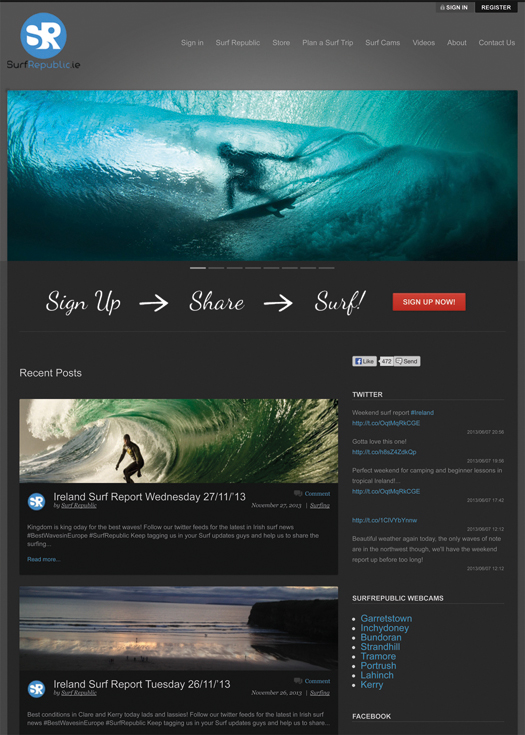
Surfing is serious business to the team behind Surf Republic, run 'by Irish surfers for Irish surfers' and built around a commitment to 'accurate Irish surf reporting, quality web cameras and advanced ocean and swell forecasts' - not to mention providing a forum for Ireland's growing community of waveriders. News? They keep things up to date so you'll never miss a swell. Social media? Get connected on Facebook and Twitter. Want to see how the water looks from wherever you happen to be? Links to eight surf cameras should sort you out!
Brokerage Award
MGM Boats - www.mgmboats.com
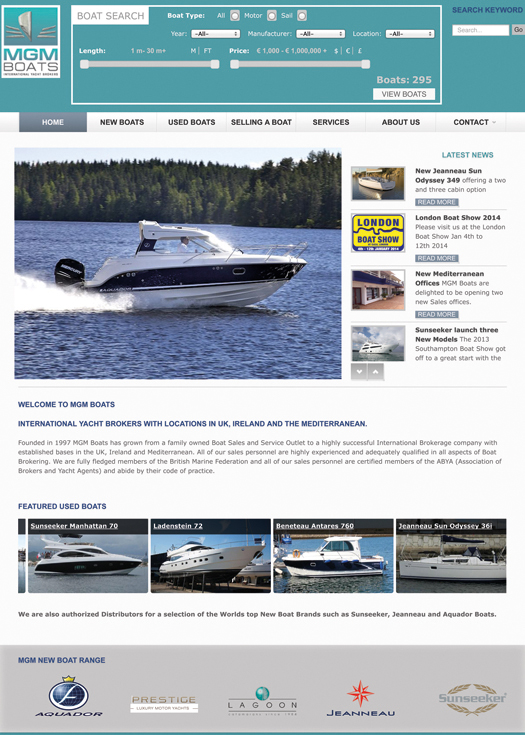
MGM Boats has been ahead of the game when it comes to expanding its boat brokerage vision from Britain and Ireland to the continent and far beyond, establishing offices in the Mediterranean and making its presence known at boat shows as far afield as Dubai and Russia. Its website takes its reach fully global, listing hundreds of new and used boats between 15 locations worlwide that can be quickly filtered by your requirements, from brand to size to price. MGM Boats makes selling your vessel easy, too, while maintenance is a doddle thanks to their various boatyard services, all fully detailed online.
Chandlery Award
CH Marine - www.chmarine.com
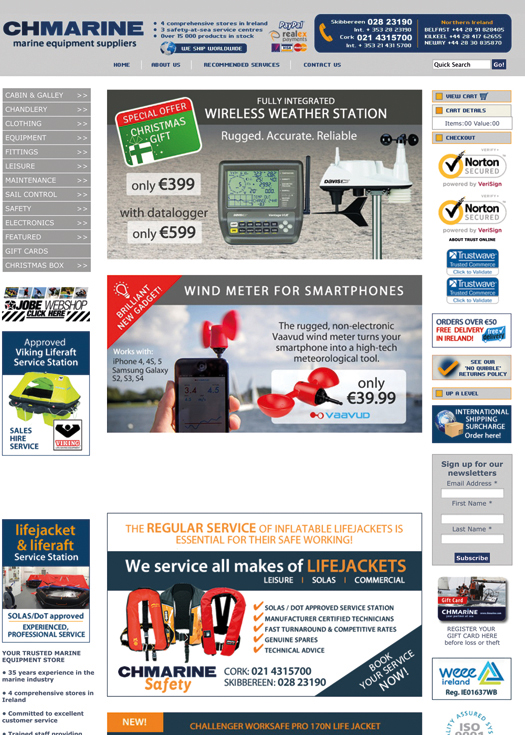
CH Marine is billed as 'Ireland's leading marine equipment supplier' and it's easy to see why, boasting as it does an impressive range of chandlery, sail clothing, the latest electronic gadgets and more, available via five walk-in superstores nationwide (in Cork, Skibbereen, Belfast, Kilkeel and Newry) and its fully stocked and browsable online shop, which provides free delivery in Ireland for orders over €50. CH Marine also ships worldwide, broadening its market considerably. The site also links to CH Marine's nationwide network of chandlery partners, making it even easier to find exactly what you want.
Clubs Award
Kinsale Yacht Club - www.kyc.ie
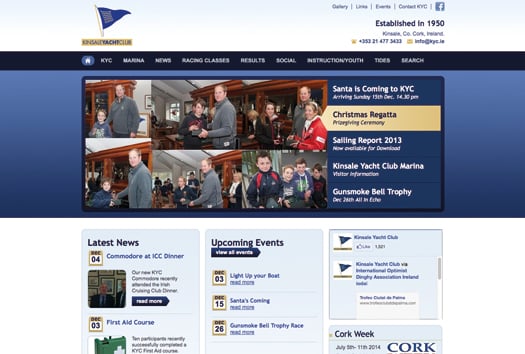
Compared to Ireland's storied yacht clubs - Kinsale Yacht Club, established in 1950, is the baby of the bunch. But does its comparative youth mean the club's more clued in to the power of the web? It's sleek, club livery themed website is certainly good evidence for that, presenting the latest news, results, reports and social connections up front - Facebook and Flickr both used well - and boasting a pagerank to make the competition green with envy.
Classes Award
Flying Fifteen Association of Ireland - www.flyingfifteen.ie
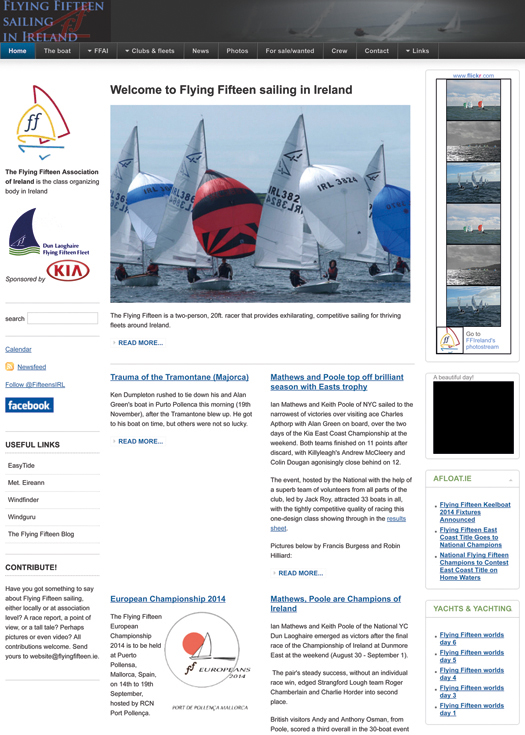
The Flying Fifteen Association of Ireland may not have the sleekest website in appearance, but they're streets ahead of their fellow sailing classes in terms of knowing how to use it. Boat specs and club details are all easy to find on the site that keeps members and the public alike regularly informed on the latest results, fixtures and other events, and engaging with the Flying Fifteen community via social media - including a Flickr page for beautiful on-the-water shots, something that should be noted by the rest.
Safety Award
Irish Water Safety - www.iws.ie

'Promoting water safety in Ireland' is the goal of Irish Water Safety, the national charity that works tirelessly to educate the public about respecting the water. After an exceptionally hot summer that saw an alarming rise in drowning tragedies, the work of the charity and the lifeguards its helps train is needed now more than ever. The first line is this website, an efficiently designed connection to nationwide training courses, water safety advice and rescue services to get the public clued in to safer behaviour at the beach, by the pool - anywhere there's water.
Inland Award
Waterways Ireland - www.waterwaysireland.org
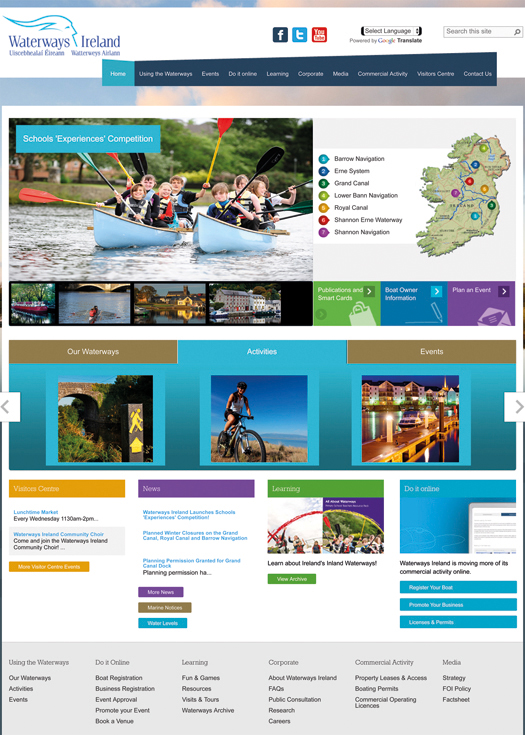
The cross-border navigation authority Waterways Ireland launched its new website earlier this year and it's a significant improvement as a resource, putting everyday usage of Ireland's rivers, lakes and canals to the fore. A colour-coded system makes distinct every one of the seven major water systems across the island of Ireland, each with its own section detailing maps, navigation info and activities. Marine notices and events nationwide are available with a single click, as are education resources and registration for waterways services. The Waterways Ireland website is doing it right.
Ports Awards
Port of Cork - www.portofcork.ie
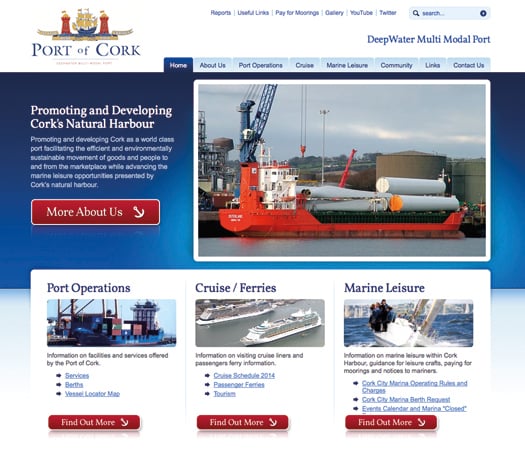
Ireland's commercial ports are well served online, but the Port of Cork website is far ahead of the class. Distilling everything one wants from a port website - shipping times and services, cruise and ferry schedules, and berthing details for visiting boaters - into a simple but effective modern and clean layout, the Port of Cork site follows the axiom 'less is more' to the correct effect. Community engagement is another important aspect, and one can't ignore the port's popular and active Twitter account.
Marinas Award
Greystones Harbour Marina - www.greystonesharbourmarina.ie

Greystones in Co Wicklow was the brightest spot on the Irish marinas map with the launch of its world-class berths earlier this year. And it's little wonder that Greystones Harbour Marina has a website to match. Cleanly designed, with direct links to details of its available berths - plus integration with boat sales partner BJ Marine - and active on social media over its first summer season, the website's doing a wonderful job of putting Ireland's newest marina on the international stage. Here's looking forward to 2014's season arrivals!
Conservation Award
Irish Whale and Dolphin Group - www.iwdg.ie

The Irish Whale and Dolphin Group knows how to put the power of the web to its advantage, using its website as a platform to educate about the many species of whale, dolphin and porpoise that frequent Ireland's shores - and get the public involved in gathering data on sightings and strandings (both can be reported directly on the site) to assist in its important conservation work. The site's news and events sections are regularly updated, and the IWDG also reaches out via a very active Facebook page with thousands of followers.
Afloat.ie will be promoting maritime web initiatives throughout 2014. Please get in touch with any website information, enewsletters or social media campaigns
Galway Windsurfers Set Paddle Board Record
#Surfing - A trio of Galway windsurfers completed the 95km round trip to and from the Aran Islands last weekend - setting a new Irish record for stand-up paddle boarding in the process.
The Irish Times reports on the successful adventure by Dan Gardner, Daniel King and Joe Gallagher, who embarked on the challenge to raise funds for the Galway RNLI lifeboat service.
Setting out before 5.30am on the morning of Saturday 8 June, they returned to the Galway Docks before 11pm that night - stopping at the halfway mark for lunch on Inis Mór.
The trio are each believed to have covered some 4,000 strokes an hour to make their record time of 17 hours 33 minutes. The Irish Times has more on the story HERE.
In other surfing news, the Sunday Independent reports on a website that's seeking to connect surfers of all levels with the right waves for them.
Waterford-based Liam Sinnott set up Swellseekers.ie with business partner James Hassey two years ago, filling a gap in the market for booking surfing trips online at a time when Ireland was only just emerging as a world-class surfing destination.
Though the site currently only takes bookings for surfing and other watersports in the Waterford area, Sinnott says he hopes to expand his site's scope nationwide by next year to serve a growing wave-riding community of "50,000 surfing all year round".
RNLI Mechanic Plots Online Course For Rosses Point Shanty Fest
#MaritimeFestivals - Organisers of the Rosses Point Shanty Festival didn't have far to cast their net when they needed someone to design their new website.
The maritime festival in aid of Sligo Bay RNLI landed a handy catch in a web designer with the sea flowing through his veins.
Not only is Daryl Ewing the mechanic for Sligo Bay's lifeboat and skipper of Ewing’s Sea Angling and Boat Charters, he is also a dab hand at plotting a course in web design.
The new website gives all the details for Rosses Point’s big event from 14 to 16 June, including the programme and details on performers who are drawn from throughout Europe.
As previously reported on Afloat.ie, the festival is now in its fourth year and has become Ireland’s premier shanty event.
"It’s great to see such a brilliant festival celebrating one of Sligo's best assets and maritime history," said Ewing. "I hope it continues long into the future, and encourage everybody to come out, take part and join in the festivities for such a great cause."
New Site Helps Finding Boating Courses Plain Sailing
#SAIL TRAINING - A new website designed to help make it easier and quicker to find boating training courses across the UK, US, Europe and worldwide has just been launched.
The Boating Hub is aimed at both beginners and more experienced boating enthusiasts, and covers a wide range of RYA, ASA and Yachting Australia accredited and alternative non-accredited courses for power, motor and sail.
The new site streamlines the often time-consuming and frustrating process of looking for boating courses, bringing together for the first time all relevant opportunities for beginners and advanced enthusiasts alike in one simple place. The site has been designed to make it almost effortless for anyone to find the information they want in just a couple of mouse clicks.
Simply choose the type of course you’re interested in, and then choose the country or region you would like to train in, and you will be immediately presented with a comprehensive list of all relevant training centres and courses, including the course dates, a description of what the course includes, and details of any experience required. Full details of the course can be obtained by contacting the boating training centre directly through The Boating Hub.
Never again will you miss out on exciting and relevant training courses simply because you weren't previously aware of a particular training centre or course type.
Additionally, by going through the website both training centres and boating enthusiasts looking to develop their skills can find each other more easily than ever before.
Whether you're just starting out in boating for the first time, looking at extending your knowledge and experience, or aiming to gain a formal, recognised qualification in a specialised field, The Boating Hub could be the perfect way to launch your journey.
For more visit The Boating Hub at www.TheBoatingHub.com.
Irish Sea Far From 'Dirty, Lifeless' Says New Website
#MARINE WILDLIFE - The UK's Wildlife Trusts have launched a new website in an effort to redress the idea that the Irish Sea is "a dirty, lifeless" place.
As BBC News reports, the trusts' Cheryl Nicholson put down the Irish Sea's poor image, saying "nothing could be further from the truth".
"Our sea is home to so many amazing species and habitats," she added, "but sadly, after centuries of neglect, it is not in a good state. We must act now to protect the Irish Sea from the depths through to the coastal shallows."
The new website is part of a campaign by wildlife trusts throughout northwest England, Wales, Northern Ireland and the Isle of Man to establish 15 Marine Conservation Zones recommended for the area.
The zones, if officially designated, would provide "a haven for wildlife to recover and thrive", said Nicholson.
As previously reported on Afloat.ie, plans to establish such zones in the Irish Sea have been shelved till 2013 at the earliest after pressure from fishermen, boaters and other groups.
BBC News has more on the story HERE.
Lyons Hopes For a Special Cork Week in 2012
#CORK WEEK - Pat Lyons of Royal Cork Yacht Club has spoken to website The Cork News about the city's hopes for the 2012 Cork Week regatta.
Crosshaven in Cork Harbour will host the club's biggest regatta - which takes place every two years - from 7-13 July this summer.
“Sailing in Ireland and Cork is in great shape,” says Lyons, who is expecting more than 250 boats to pack the harbour for racing and more.
The event is also perfectly timed just two weeks ahead of the 2012 Olympic Games in London, where Royal Cork Yacht Clubman Peter O’Leary will vie for gold with Dublin yachtsman David Burrows in their two-man keelboat.
Though the economic downturn has had a serious effect, costs have been cut across the board and some rules have been relaxed to allow for the widest possible level of participation.
“There are three factors that make Cork special," says Lyons. "Firstly, there is the number of boats and the various fleets. Secondly, there are 10 races planned. While that doesn’t always pan out due to the weather, we have pretty settled weather conditions and an excellent coastline in Cork, with hills running down to the sea.
"And finally, there is the harbour, which, if the weather impacts, provides excellent shelter. We’ve always been able to achieve a higher level of competition than a lot of other regattas, with at least one or two races per day.”
As previously reported on Afloat.ie, preparations for the event have already kicked off with the launch of a dedicated new website.
The Cork News has more on the story HERE.
Is Your Sailing Website Always Out of Date? Here's the Solution!
Would a constant stream of Irish sailing and boating news give your site the lift it needs?
Afloat.ie, Ireland's leading source of boating and sailing news, offers a news feed to bona fide clubs and classes wishing to keep web sites fresh and up to to date.
Webmasters can avail of the simple RSS feed and all we ask in return is for you to observe our rules and give Afloat.ie a link on your club homepage.
It couldn't be easier, click for the Afloat. ie RSS feed.
Tall Ships Races Could Mean Big Money for Waterford
This weekend's Tall Ships Races in Waterford could bring in up to €35 million to the local economy, according to Fáilte Ireland.
Gerry Breen of Fáilte Ireland also told The Irish Times that the event would complement the new Viking Triangle development in the city, which is hoped to be a major tourist attraction.
Des Whelan, chairman of the Waterford Tall Ships Race 2011, said the official website had registered nearly 200,000 hits, and hotels in the city are almost completely booked out.
Opening the weekend's festivties this evening are a fashion show on board the Russian sailing ship Mir, and a special concert by Roxy Music singer Bryan Ferry.
The first of three impressive fireworks displays will also light up Waterford's skies at 10.30pm tonight.






























